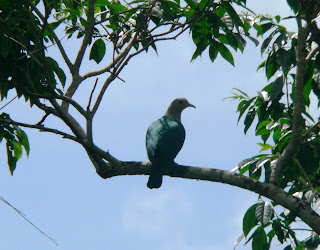This young Nankeen (Rufous) Night-Heron was seen from my kayak during a 22-kilometre paddle down the Upper Maroochy River on the Sunshine Coast. A couple of Striated Herons were also seen but no sign of Black Bittern.
I launched the boat where Ninderry Road crosses the Upper Maroochy River. An hour's paddling downstream and I am under the bridge on the Yandina-Coolum Road. I was surprised to see a large number of Welcome Swallows evidently attending nests in various stages of construction, firstly because this bird does not normally nest in colonies, and secondly because it is late in the season to be nesting.
A little way down from the bridge, the north and south arms of the Upper Maroochy meet. Here is it is possible to enjoy fine views of Mt Ninderry to the north.
The river snakes its way through an extensive area of sugarcane fields, often with little vegetation remaining on the banks. Waterbirds can be seen anywhere, however, such as these Australasian Darters - an adult and an immature.
And these Little Black Cormorants.
Eastern Water-Dragons occur all along the river, but become less numerous as the water becomes more salty downstream.
I saw plenty of White-breasted Woodswallows, including this trio.
Well downstream, where the river joins Coolum Creek, extensive areas of mangroves occur. This Mangrove Gerygone came in for a look.
Brown Honeyeater is the most numerous bird in the mangroves. It is curious that there are no Mangrove Honeyeaters here, although they are abundant further south around Pumicestone Passage.
Golden Whistler appears to be resident in the mangroves.
Night-Herons are shy and difficult to photograph. It took a while to nail this one.
I launched the boat where Ninderry Road crosses the Upper Maroochy River. An hour's paddling downstream and I am under the bridge on the Yandina-Coolum Road. I was surprised to see a large number of Welcome Swallows evidently attending nests in various stages of construction, firstly because this bird does not normally nest in colonies, and secondly because it is late in the season to be nesting.
A little way down from the bridge, the north and south arms of the Upper Maroochy meet. Here is it is possible to enjoy fine views of Mt Ninderry to the north.
The river snakes its way through an extensive area of sugarcane fields, often with little vegetation remaining on the banks. Waterbirds can be seen anywhere, however, such as these Australasian Darters - an adult and an immature.
And these Little Black Cormorants.
Eastern Water-Dragons occur all along the river, but become less numerous as the water becomes more salty downstream.
I saw plenty of White-breasted Woodswallows, including this trio.
Well downstream, where the river joins Coolum Creek, extensive areas of mangroves occur. This Mangrove Gerygone came in for a look.
Brown Honeyeater is the most numerous bird in the mangroves. It is curious that there are no Mangrove Honeyeaters here, although they are abundant further south around Pumicestone Passage.
Golden Whistler appears to be resident in the mangroves.
Night-Herons are shy and difficult to photograph. It took a while to nail this one.


















































